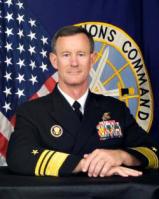
Vice Admiral William McRaven
The man who commanded the SEAL team that hunted down and killed Osama bin Laden studied to be a reporter. If the Pulitzer Prize board establishes a new category — for killing the world’s most wanted terrorist — it’s a safe bet Bill McRaven will win it next spring.
Vice Adm. William McRaven, himself a SEAL, was on the ground in Afghanistan as bin Laden met his end, linked electronically to CIA chief Leon Panetta at agency headquarters in Langley, Va. “I have to tell you that the real commander was Admiral McRaven,” Panetta told PBS Tuesday night. “He was on site, and he was actually in charge of the military operation that went in and got bin Laden.” (More on Time.com: See photos of the Navy SEALs in action)
So just who is this reporter-turned-frogman-turned-giant-killer? He currently heads the military’s 4,000-strong and secretive Joint Special Operations Command at Fort Bragg and Pope Air Force Base in North Carolina. Assuming Senate confirmation, he’ll soon pick up his fourth star and head to Florida to run U.S. Special Operations Command at MacDill Air Force Base in Tampa. That will make him the Pentagon’s top commando among the 57,000 people working for SOCOM. He’s married, with several kids.
PHOTOS: Inside bin Laden’s Lair
McRaven hedged his bets while studying journalism at the University of Texas in Austin before graduating in 1977: he also was a member of the Navy ROTC program. “You wouldn’t expect a journalism major,” former deputy CIA chief and ex-Navy admiral Bobby Inman told the San Antonio Express-News, “to end up running special forces.”
But it looks like McRaven picked the right career path: in his 35-year career, McRaven went from being a SEAL platoon commander, to heading a SEAL team, to running U.S. special operations in Europe. But he didn’t give up everything he learned in journalism school: in 1996 he published Spec Ops, a book on the art of special operations based on eight case studies. He concluded the keys to successful missions are Simplicity, Security, Repetition, Surprise, Speed and Purpose.
McRaven is highly-regarded in the dark world of special operations for improving the JSOC targeting center created by Stanley McChrystal, the Army general who retired last year after Rolling Stone quoted his staff making disparaging comments about top members of the Obama Administration. The unit has gotten high marks for compressing the nation’s flow of military and civilian intelligence into targets, times and places for action. In other words, he has spent years “shortening the kill chain,” linking curiosity, detection, tracking and destruction. (More on Time.com: See photos of the White House Situation Room)
Defense Secretary Robert Gates, in announcing McRaven’s promotion in March, said McRaven “has led a JSOC team that has been ruthlessly and effectively taking the fight to America’s most dangerous and vicious enemies.” As JSOC chief, he commands what the public knows as SEAL Team 6 — the toughest, most skilled SEALs — but officially known as the Naval Special Warfare Development Group, or simply DevGru.
McRaven deployed SEAL Team 6 to great effect early Monday in Pakistan. Back at CIA headquarters, Panetta and his team monitored McRaven’s men from a windowless seventh-floor conference room. As he and his team waited for McRaven to report on whether bin Laden was indeed at the compound, Panetta says the room was tense. “I kept asking Bill McRaven, ‘O.K., what the hell’s this mean?,’ ” Panetta told Time‘s Massimo Calabresi. When McRaven finally said they had gotten “Geronimo,” their code name for bin Laden, “all the air we were holding came out,” Panetta says. Not a bad day’s work for a would-be journalist. Sure as heck beats writing about it. (More on Time.com: See photos of bin Laden’s death in headlines)


